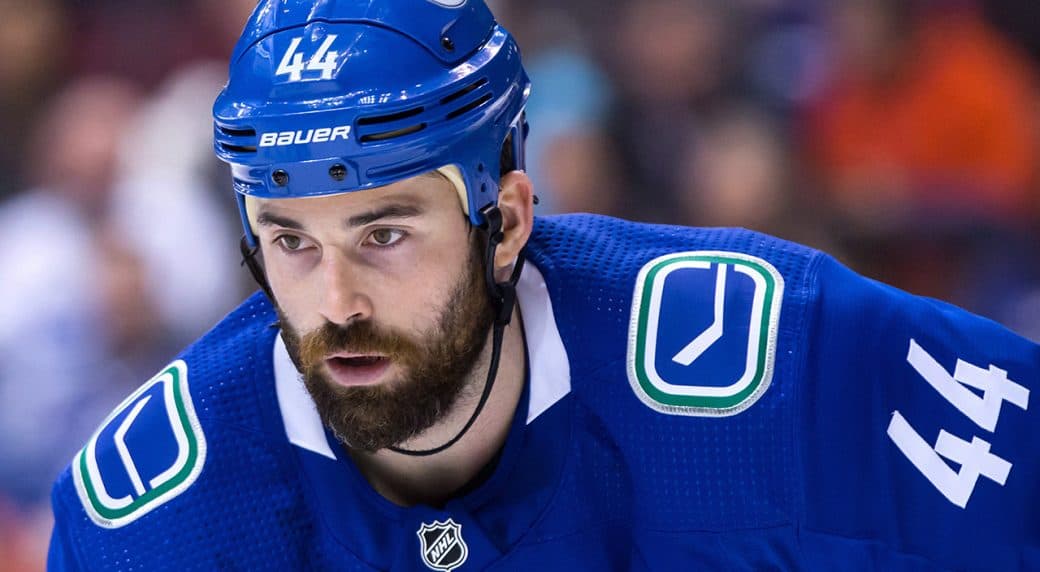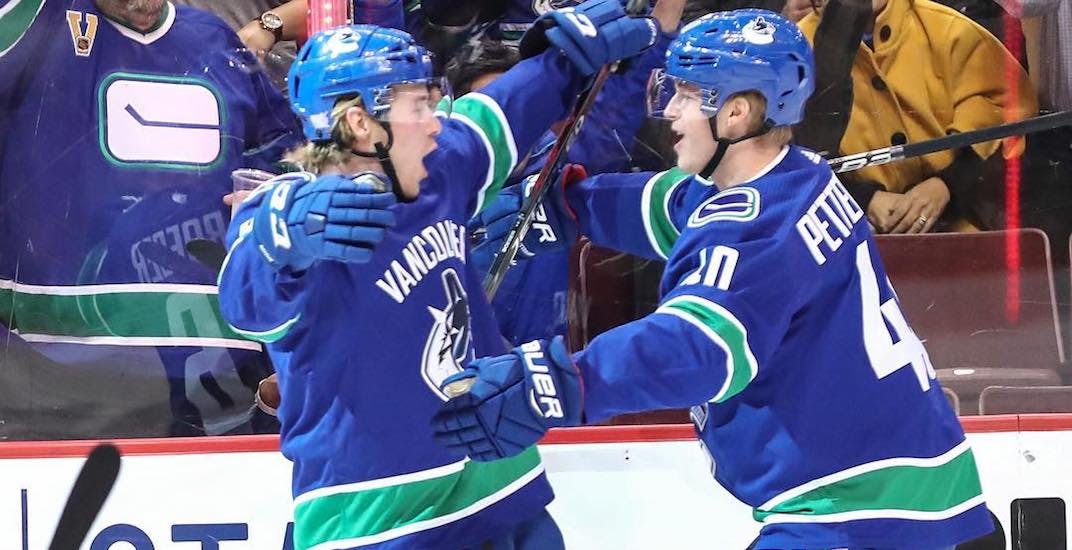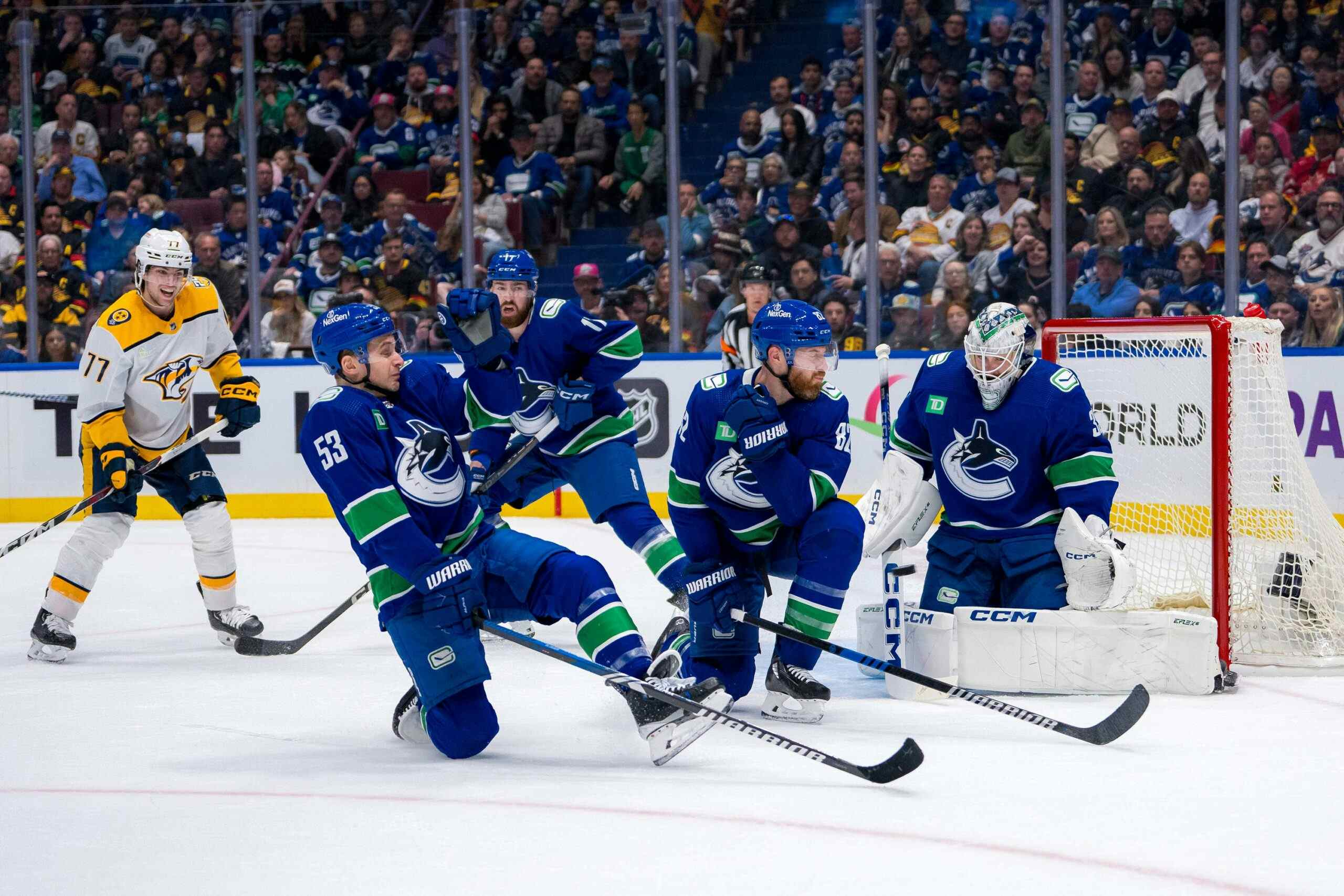The Flying Take: Time Is a Flat Circle, Trouble in Utica, and Putting an End to the Gudbranson Wars

5 years ago
We’re nearly halfway through January and the Canucks sit just a few points out of a wildcard spot.
It’s a brave new world, and a terrifying one at that. The prospect of the Canucks making the playoffs may be exciting to some, it shouldn’t be. And no, that isn’t just because it will cost them a chance at Jack Hughes.
Let’s think for a moment about what happened the last time the Canucks outperformed expectations.
They swapped a centre who was under team control for another two years at $1.9 million for another centre who was quickly extended for a yearly figure over twice that much.
Since that trade, the player they gave up has played 258 games, and has 109 points. He had a career year, won a Stanley Cup, and signed a new deal, and still makes less than the player the Canucks got. The player the Canucks acquired has amassed nearly a season and half’s worth of man games lost since he was acquired, playing 177 games and scoring 73 points. He’ll be on the books for $4.375 million until 2021. They swapped draft picks too, and gave up the better one in the process.
They swapped a pick to Montreal to essentially get rid of a player that had been experiencing off-ice issues and got 35 slow, ineffectual games out of Brandon Prust. Then they swapped another pick in exchange for Philip Larsen, who flopped.
In the summer, they traded a young player who’s on pace for 35 points and a pair of draft picks for a defenseman who, to put it generously, has not worked out quite the way they had planned (more on that later).
Finally, on July 1, they signed a declining Loui Eriksson for six years at $6 million per year and that contract will be an albatross around their necks until well into what should be their competitive window.
Call it cherry-picking if you want. I’m sure you can find grounds upon which to defend each one of these moves; but the truth is, this is a results-based business, and the results haven’t worked out in the Canucks’ favour. They’ve had their fare share of wins since then, but in a 13-month period from May 25, 2015 when they traded for Erik Gudbranson to July 1, 2016, when they signed Loui Eriksson; the team made a flurry of moves, all meant to help keep them competitive, and there’s scarcely a nice thing to be said about any of them.
Some would say that they’ve righted the ship and won’t make these mistake again. I look at the way they’ve spent money in free agency in past two years and say this:
What has been will be again,
what has been done will be done again;
there is nothing new under the sun.-Ecclesiastes 1:9
1. I spoke at length about Kole Lind’s struggles in the AHL this season a few weeks ago in this very column, hoping it might elicit a response from Comets Cory. The Comets have since become a hot-button issue in this market for other reasons, but we’ll get to that later. First, here’s Cory’s update on Lind since returning from injury in late November:
“He was out with his injury from Oct. 20th-November 28th. He has played 16 of the team’s 18 games since. He’s worked with three centers: Cam Darcy for 8 games, Brendan Woods for 4 games and Tony Cameranesi 3 games. Bancks played one game in the middle in there as well. He’s had 5 different wingers on the other side: Bancks for 4 games, Tanner MacMaster for 4 games, Gaunce for 2 games, Dahlen for 1 game and Vincent Arseneau for 5 games.”
It’s not exactly a murderer’s row of offensive dynamos, and ECHL alum Vincent Arseneau in particular sticks out as a less than ideal fit, but there may be some method to the madness.
CORY:
“Kole’s best run of games has been his most recent with four points in his last four games playing with Darcy and Arseneau on what has become a very effective, high energy, hard forechecking line. These last handful of games are the most engaged Lind has looked all season.I understand that it’s easy to look at things from the outside and say that it’s easy to sit Vincent Arseneau. I get it. He’s on an AHL deal and will never be an NHL player. The thing is, Kole Lind has played the last four games on a line with him and Cam Darcy and Lind is playing his best hockey of the season with four points during that span and looking more engaged than he has all year. If you sit Arseneau and play Gadjovich in his stead, maybe you don’t have Lind getting going right now either.”
You can’t prove a negative, but it’s easy to see where he’s coming from.
2. Believe it or not, the Comets would appear to have a strategy in place for how they’ve handled their rookies. Criticize it all you want, but I think it’s important to at least understand what it is and pick it apart on that basis rather than just guess at what they’re trying to accomplish:
What I have seen is kids paired with at least one steady vet and often with another kid on their line as well. It is just a numbers game and the roster is constantly changing with players called up to Van, players injured in Utica and players brought in from the ECHL. It’s quite the juggling act when you break it all downI think it’s been about Cull getting the kids in where he can, playing them with at least one of his trusted solders and giving them opportunities when they do get in. Every kid, including Palmu has seen PK time, PP time, or both. He plays kids late in games when he is protecting a lead or trying to get back into a gameI will say this. I was somewhat surprised when they brought Archibald back after signing Roussel, Schaller and Beagle. I was also surprised to see the Comets bring both of Woods and Arseneau back on AHL deals. Woods has been injured a bunch, he missed most of last year too. So he hasn’t been jamming up any kids, especially since he plays the middle. But Arch put a wrinkle into things when he made his way back down.I see what the coaching staff is trying to do. It’s similar to Travis Green playing Goldy with Beagle and saying in his presser after that he did it with the hopes that Goldy would see Beagle’s effort level from shift to shift etc. I see the same thing in Utica when the kids have been paired with specific vets to get certain parts of their games going.So they have guys like Bancks, Hamilton, Woods, Darcy, Arseneau who are all high character, hard working, never-take-a-shift-off kind of guys. They don’t have a ton of skill, although the Comets would have been hard pressed to make the playoffs without Darcy last year, but they do bring an unquestioned effort level from shift to shift.
I saw it happen from the start of the year, I kept tabs on it because it was so noticeable right away. The kids all took their turn with a handful of games with Bancks as their pivot. Jasek responded well and worked harder along the boards and battled harder from shift to shift. Lind had less success with him. Palmu had trouble keeping up to the pace that Bancks played with. Gadjovich has had some of his best shifts with Bancks either on his other wing or in the middle.
It’s worked with some players. Zack MacEwen took off midway through last season and hasn’t looked back since. Jasek was an afterthought in the system a year ago and now he’s clicking along at a half-point-per-game. Dahlen’s performance this far has perhaps been a tad underwhelming, but he’s been in the lineup all season as has gotten a fair share of special teams time.
It hasn’t worked as well for others, and they’re the ones you’re hearing about. The Comets have handled young players in a similar manner to the parent club, and as you might guess, it’s been hit and miss. Another thing they have in common is a lack of creative centremen in the system to be called upon when an injury arises, and I wouldn’t be surprised if having Adam Gaudette and Brendan Gaunce spend time in Vancouver this season has cost the Comets more than just a few standings points.
3. Obviously, the big story out of Utica this week is Petrus Palmu’s comments about his decision to return to Finland after struggling to stick in the Comets’ lineup.
The Palmu quotes really brought things to a head the other day and I think a lot of people are really only seeing things from one perspective. I get that, I understand the angst about players sitting. On the flip side, I’ve seen direct results where kids games have taken a noticeable step while playing with the very same players that everyone wants to have sitting in the press box. I can maybe help some folks understand the balancing act.When it comes to Palmu, for me…he just couldn’t find the time or space to play his game when he got in. He showed an active stick in all three zones and his effort level in his boards battles was there, but he was getting shoved around more than I would have liked. The think he can still be a player and I can see him coming back next year better prepared for the league.I think it’s been about Cull getting the kids in where he can, playing them with at least one of his trusted solders and giving them opportunities when they do get in. Every kid, including Palmu has seen PK time, PP time, or both. He plays kids late in games when he is protecting a lead or trying to get back into a game.
I spoke with Cory for a long time about the way the Comets’ coaching staff has come under fire recently and it’s clear he feels some of it has been unfair, especially when much of the criticism comes from people who rarely, if ever, watch Comets games.
It’s a good point. At the same time, I don’t think you really need to watch much Comets hockey to be frustrated with the way the Palmu situation played out.
There was one thing we both more or less agreed on: there’s a wrinkle to the situations with Petrus Palmu, Jonah Gadjovich, and to a lesser extent, Kole Lind, that hasn’t really been covered.
CORY:
We talked about submarining a kid’s development by putting two on one wing. If we look at the rookies to start the year in Utica, you can see how the coaching staff had their hands full with sorting out a roster.1 .Dahlen2. Gaudette (C)3. Lind4. Palmu5. Gadjovich6. MacMaster7. Jasek
That’s not counting Juolevi on the back end. So they had 8 raw rookies to start the year in Utica. Jasek coming over late last year on his own dime put another wrinkle into things. I’m not sure they were expecting him to make the jump like he did. All of a sudden, they had Jasek to go along with Gadjovich, Dahlen, Lind and Palmu coming inThis is the point where we are at. This organization hasn’t had “this many” young prospects all coming in at the same time since I can remember. Our market hasn’t gone through this experience of having to see how kids develop in a system when so many will need extra attention. They started with 8 rookies in Utica this year who all have a “chance” to get NHL minutes at some point…even Tanner MacMaster who is a rookie on an AHL deal who has looked good when he’s been in. That’s a lot of young player’s getting their first look, at any level. Imagine if the Canucks started the year with 8 rookies on the roster?There are 8 open wings in any given game…and six rookies up front. If you don’t want to play two of them together on one line and “submarine” them, how do you make that work and get them all in? MacEwen needs to play too, right? Boucher? Gaunce? Add in Carcone when he was here and Archibald as well…how do all of the kids get in and be out in a position to succeed?
The Comets have run a pretty consistent strategy when it comes to developing their young players. You can quibble with it, but it’s been their M.O. for a while now. It should have been clear from the outset that the Comets were going to have trouble accommodating all the extra bodies this year if they went with this strategy (and frankly, even if they didn’t. Eight rookies is a huge number for an organization at any level). The Comets routinely go through 50+ players a season, especially when injuries hit the big club. With that much uncertainty and that many moving parts, the Canucks front office ought to have foreseen trouble arising.
If there wasn’t room for Palmu on the roster, why leave Finland in the first place? People talk about him needing to get accustomed to the North American ice, but he spent three years playing on it in the OHL, and put up 189 points in 176 games.
You want him to develop into an offensive player. Why not let him play another year in Liiga with Kappo Kaako and bring him over next year when there’s more room? Instead, he’s ended up back there anyway and wasted a half-year of development.
It isn’t the first time it’s happened, either. Jonathan Dahlen lost out at a shot to play with Linkoping of the SHL after contracting mononucleosis and missing all of Canucks camp. Had the team acted quickly and realized there wasn’t going to be room for him in North America, they might have been able to get out in front of it and find him an SHL team before rosters were nearly finalized. Instead, he spent another year in the Allsvenskan and plateaued.
Lack of communication has been a hot topic this week, but it’s not solely on the Comets. Clearly some wires are getting crossed at the NHL level, too.
4. Another thing that’s not getting mentioned is the possibility that maybe these kids have been over-hyped. Pro hockey is tough and players often struggle in the early goings or even wash out completely. The Canucks have a lot of legit prospects in their system, but they aren’t all cut from the same cloth.
CORY:
I think the Canucks have a couple of players in Utica who can be nice support players for the “higher end” core that is starting to form. I don’t see anyone “elite” in Utica at the moment. Not for the NHL level just yet. I think Thatcher has a chance to be an elite goalie down the road, but things will have to go right for him. He will have an adjustment period and fans will worry, but I think he has the mental makeup and the tools to be a very good goaltender for a very long time.
5. Darryl Keeping asked a question in the mailbag this week that got me thinking about a once-hot topic around these parts that’s fizzled out almost completely this year as the mood in Vancouver has trended towards optimism.
It was a good question. Hutton’s earned plaudits this season, deservedly. So it’s fair to ask why he’s spent so much time at even strength attached at the hip to a player who is pretty clearly a drag on his two-way ability.

But you’ve heard all about Gudbranson’s Corsi. Corsi’s no good out here. I need something more real.
Thankfully, there’s a little piece of data on Gudbranson that’s been making the rounds on social media this week that ought to do the trick.
I’ll blow that image up for the visually impaired.

Since arriving in Vancouver, Erik Gudbranson boasts the league’s worst goals-for percentage at even-strength. We’re not talking about Corsi, or Fenwick, or xG, or any of the fancy stuff. We’re talking about the only thing that matters, and the one thing that fancystats deniers say all the advanced data in the world can’t account for: goals. You know, that thing that determines if you win or lose the game. Since 2016, for every goal Gudbranson has been on the ice for, he’s given up nearly two goals against.
If that doesn’t convince you something’s wrong, nothing will. So I’m calling for an Armistice in the Gudbranson Wars. I have a Treaty you can sign. You can trust the conditions are fair, as is always the case with Treaties.
At one point in time, that little piece of information would have caused quite the stir, it would have spawned arguments and thinkpieces and ended friendships. Now? It gets a little section in the Athletties, people talk about it for maybe a day at most, and then move on. It’s clear neither side has the energy to keep up the fight.
It’s a new year, and a new CanucksArmy. From now on, we’re all about building bridges. Fighting isn’t getting us anywhere, so let’s bury the hatchet and put all this behind us.
For the sake of the kids.






